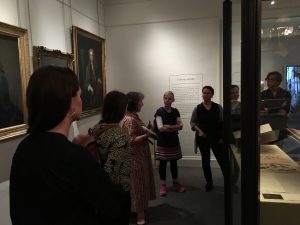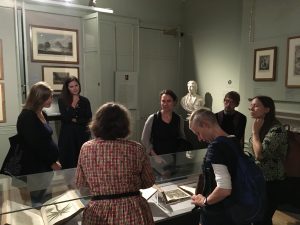By Noah Moxham and Jasmine Kilburn-Toppin
This year’s CHOTS Away Day took us to the Enlightened Princesses exhibition, now at Kensington Palace in London, following its original installation at the Yale Centre for British Art in New Haven. The palace itself made an appropriate setting, since at least one of the titular princesses, Caroline of Ansbach, had lived in it and overseen the transformation of much of its Hyde Park surroundings into something like their present form. (I had only ever glimpsed it from a distance through the park and thought it attractively modest for a royal residence. That must be a misapprehension, since it’s currently the official London accommodation of four different branches of the extended Windsor family.)
An inadvertent tour of the perimeter (we weren’t sure which entrance we were supposed to gather outside) took us past the main gate, obscured by a layer, several feet deep, of twentieth-anniversary memorial tributes to Diana, whose residence it had also been – the first of many opportunities for reflection on the scope of royal myth- and image-making. Our entrance to the eighteenth-century exhibition also took us past a display of Diana’s outfits, and even those of us who consider ourselves immune to sentiment about princesses would have had to admit that we remembered most of them, including several calculated to make you grateful that the 1980s have been over for a long time.
We were lucky to have with us Ben Marsh from the School of History at Kent, a consultant on the exhibition, and one of whose research discoveries was prominently featured in the final room of the show (of which more below), and even luckier to have Joanna Marschner, Senior Curator at Historic Royal Palaces, as a guide, one of the drivers of the exhibition and the editor of its accompanying book. Joanna conjured the world into which Caroline of Ansbach, Augusta of Saxe-Gotha and Charlotte of Mecklenburgh were recruited (the word is brutal but not misplaced), to shore up Britain’s fragile monarchy and to guarantee the Protestant succession.
It was a strikingly limited brief for these determined and highly ambitious women, and pitched them into a dramatically different environment from their respective German homelands. The princesses had been used to a scene of rather grander and more diverse urban and courtly sociability and entertainment than that which they encountered upon arrival in Britain. The exhibition outlines the roles that these princesses carved out for themselves in British cultural, political, and intellectual life. Ultimately they functioned as patrons and tastemakers, and as vectors for Continental ideas, artists, and fashions.
The range of their activities was vast, and the exhibition is correspondingly eclectic in its themes and materials. A brilliant array of visual and material cultures are on display, including prints, landscape paintings and portraits, botanical illustrations, architectural drawings, musical scores, library catalogues, taxidermied birds, gardening manuals, medical and scientific instruments, political cartoons, clothes, textiles, sculpture and tableware. The enlightened princesses brought their interests into the domestic as well as the public sphere. The large broods of protestant princes and princesses they were imported to produce had Handel as a music master, learned architectural drawing, and were even taught to handle scientific instruments by fellows of the Royal Society. Domestic portraits of the elder children trundling their smaller siblings in a handcart or solemnly practicing their music became the basis of prints that spread the image of the royal family up and down the land. Influences also worked outward, from the royal household to the wider public sphere.
Throughout, the exhibition registers shifts of scale, as the interests and activities of the princesses were projected onto different spheres. Botanists and collectors named new exotic plants for them, and sent them hand-coloured illustrations of their works as gifts; but they were also involved with new scientific establishments such as Kew Gardens, a research and social space that gained some of its fashionable lustre from the proximity of the royal household at Richmond and became a site for architectural experimentation and imperial display as well as botanical research. Inoculating the Hanoverian children against smallpox was also an intervention in a raging national debate about the treatment and epidemiology of the most devastating disease of the period.
These eighteenth-century princesses contributed to public debate about matters which impinged directly upon their own experiences and the health and productivity of the royal household. And a private audience with the Pinckneys of South Carolina was in one sense a breathlessly recorded encounter between sovereign and subject and a chat about American silk colonial fashions, and in another a microcosm of the relations between Britain and its colonies, the attempted subordination of colonial production to domestic manufacture, and the role of slavery in eighteenth-century Empire. The encounter between Princess Augusta and Mrs Eliza Lucas Pinckney is documented in this exhibition by a fascinating letter, discovered by Ben Marsh in the archives of the South Carolina Society of the Colonial Dames of America, and by a hugely striking sculpture, Mrs Pinckney and the Emancipated Birds of South Carolina, created in response to the letter by the contemporary artist Yinka Shonibare MBE (RA).
It’s worth noting that the shifts of scale the exhibition manages so well, the compression of the imperial to the domestic, and the expansion of the domestic to the national, was at least partly an effect of royal status and privilege; that not every act of scientific or artistic patronage or philanthropy was necessarily followed up to the fullest extent; that the courage shown in inoculating the royal children against smallpox has to be set against the squalid trial of the technique on condemned criminals and then orphaned children beforehand. Moreover a single room of the exhibition featuring acerbic visual satires of the princesses, by leading caricaturists such as James Gillray, reminds us that contemporaries were certainly not unanimous in praise for their royal patrons and cultural and scientific tastemakers.
As an overview of the enlightened princesses activity this exhibition made for compelling viewing, and was calculated to delight historians and archivists because of its focus on the non-obvious, on objects, instruments and paper as well as portraiture, and for the sense of widespread endeavours rather than simple pageantry and glorification.




6 comments
Skip to comment form
Muchas gracias por la información, voy a seguir leyendo su blog, me parece muy interesante, me gustaría compartirles una herramienta que me parece muy útil, una calculadora de embarazo, la conocen? es esta Calculadora de embarazo
Travel seems easy with so much information available in El corte ingles. On this site one can find the best tips related to travels.
Egipto, es un país ubicado en el extremo noreste del continente africano. La mayor parte de su territorio, está ocupado por millones y millones de granos de arena, a los que se conoce por nombre del Desierto del Sahara. Cabe destacar, la importancia del Río Nilo, que da la vida a Egipto, cruzando el país de Sur a Norte, formando un estrecho valle al Sur y un gran delta en el Norte, en su desembocadura en el Mar Mediterráneo.
Very nice article. I certainly love this site. Continue the good work!
This is a nice post explaining a lot about enlightened princess. I really appreciate your efforts to do so. Plz keep posting.
Hello, I really like your site. I think it is very entertaining. You seem extremely talented. What do you think about this site: Sculptor2000.com It has some really cool art on it. My favorite guy is this sculptor http://www.sculptor2000.com/artist-john-abery-with-the-sculpture-called-the-six-minute-man/ He has some cool art that is really weird. looks like he is from Australia. What do you think? Thanks so much for your feedback and thanks for the awesome posts that you share.